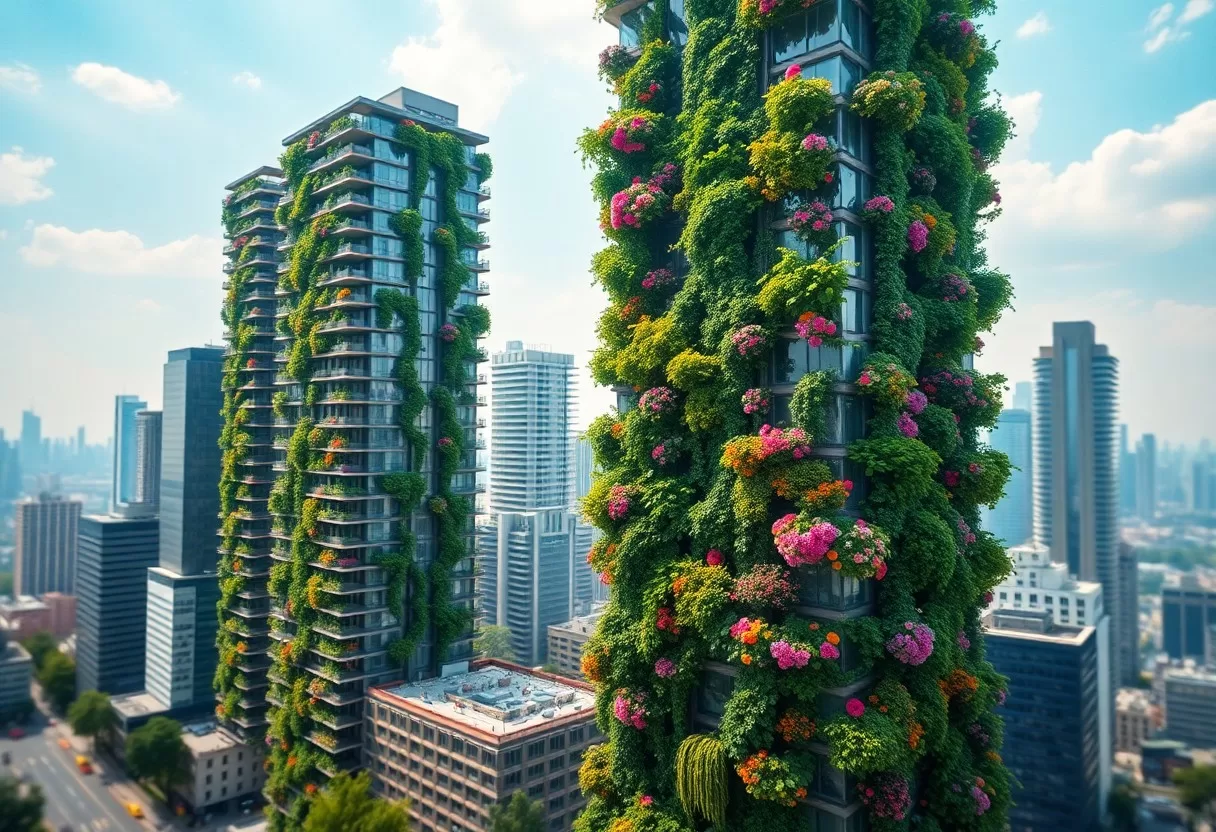The Rise Of Urban Vertical Gardens – Transforming Cities Into Green Oases
With urbanization rapidly expanding, you might be wondering how cities can maintain their livability and greenery. Enter vertical gardens, an innovative solution that allows you to transform even the smallest spaces into lush, green environments. These gardens not only enhance the aesthetic appeal of your surroundings but also improve air quality, reduce noise pollution, and provide habitats for urban wildlife. As you explore this trend, you will discover how these green oases can play a pivotal role in creating sustainable urban living for future generations.
Key Takeaways:
- Urban vertical gardens enhance biodiversity by providing habitats for various species, improving the ecological balance in urban environments.
- These green structures contribute to air purification and temperature regulation, helping to combat urban heat islands and improve overall air quality.
- Vertical gardens offer aesthetic appeal, transforming bland walls and buildings into vibrant green spaces that enhance community engagement and local pride.
- Incorporating vertical gardens supports sustainable practices, such as urban agriculture, allowing cities to grow food locally and reduce reliance on transportation.
- Governments and organizations are increasingly recognizing the importance of vertical gardens, leading to greater investment in green infrastructure and policies that promote urban greening initiatives.
Urban Gardens: A Solution to Urban Challenges
Urban gardens provide a multifaceted approach to combating the myriad challenges faced by city dwellers. From alleviating the strain on public infrastructure to enhancing community well-being, these green spaces serve as a remedy for environmental degradation, food deserts, and urban isolation. By integrating nature into densely populated areas, urban gardens help foster a sense of community while addressing pressing issues like climate change and resource scarcity.
Alleviating Air Pollution and Urban Heat
Urban gardens play a pivotal role in combating air pollution and mitigating urban heat. Plants absorb carbon dioxide and release oxygen, significantly improving air quality. In fact, studies show that increasing urban greenery can reduce air pollutants by as much as 30%. Furthermore, vertical gardens can lower ambient temperatures by up to 5 degrees Celsius, offering a cooling effect that benefits both people and the urban environment.
Enhancing Biodiversity and Urban Ecosystems
Vertical gardens are vital for boosting biodiversity in urban landscapes, offering crucial habitats for pollinators and other wildlife. In cities where natural habitats are scarce, these gardens attract birds, bees, and beneficial insects, promoting a sustainable urban ecosystem. As a result, the introduction of diverse plant species can enhance the overall health of your local environment, fostering resilience against invasive species and diseases.
Incorporating a wide variety of native and adapted plants in your urban garden not only enriches the landscape but also contributes to a stable ecosystem, which is crucial for maintaining biodiversity. Studies have shown that urban areas with increased green spaces, including vertical gardens, harbor 50% more species compared to those with limited greenery. By supporting local flora and fauna, you contribute to a more balanced and vibrant urban ecosystem that ultimately benefits everyone in your community.

Design Innovations Fueling Vertical Gardening
Innovative design techniques are at the forefront of vertical gardening, enabling you to seamlessly integrate greenery into urban environments. Modular systems, custom planter boxes, and gravity-fed irrigation solutions are transforming how plants are cultivated vertically, making gardening accessible even in the tightest spaces. These advanced systems not only focus on maximizing space but also enhancing the overall aesthetic and functionality of urban landscapes.
Advanced Hydroponics and Aeroponics Techniques
Advanced techniques like hydroponics and aeroponics propel the functionality of vertical gardens to new heights. These methods allow you to grow your plants without soil, utilizing nutrient-rich water solutions or a mist of nutrient solution, which promotes faster growth and higher yields. Benefits include:
- Reduced water usage compared to traditional gardening.
- Faster growth rates, with some plants maturing twice as quickly.
- Enhanced control over nutrient delivery for optimal plant health.
Benefits of Advanced Techniques
| Hydroponics | Highly efficient, offering water savings and increased growth rates. |
| Aeroponics | Uses up to 90% less water than soil gardening, promoting sustainability. |
Aesthetic Considerations: Blending Nature with Architecture
Your vertical garden can significantly enhance urban architecture by seamlessly marrying natural elements with man-made structures. Utilizing various plants and materials, designers are crafting installations that not only purify the air but also create striking visual contrasts. The thoughtful incorporation of greenery into building facades or interior spaces can completely transform the atmosphere, making your surroundings more inviting and vibrant.
Consider the potential of a vertical garden that mirrors the architectural style of a building, utilizing plant species that complement its structural lines. By integrating features like LED lighting and artistic trellises, your garden can become a focal point, drawing attention from passersby and creating a dynamic experience. Several cities, such as Singapore and Milan, illustrate how these aesthetic innovations can redefine public spaces, enrich community well-being, and inspire sustainability in urban design.
Economic Benefits of Vertical Gardens
Vertical gardens not only enhance the aesthetic appeal of urban landscapes but also offer substantial economic benefits. As cities become more congested and property values rise, these green installations provide a unique opportunity to increase marketability and attract investment. Their presence fosters community development and boosts local economies by creating vibrant, livable environments that businesses and residents want to be a part of.
Increases in Property Values and Local Business Appeal
Property values in areas with vertical gardens tend to appreciate faster than those without green spaces. Real estate studies show that homes and commercial buildings located near parks or green walls enjoy a 15% increase in value. This increase creates a desirable urban environment, which attracts new businesses and enhances customer footfall, ultimately boosting sales for local retailers.
Cost Savings through Energy Efficiency and Green Infrastructure
Investing in vertical gardens can lead to significant cost savings in energy consumption. By providing natural insulation, these gardens help regulate temperature, reducing the need for artificial heating and cooling. In fact, buildings with vertical gardens can see energy savings of up to 30% annually. Furthermore, green roofs and walls mitigate stormwater runoff, decreasing the burden on city sewer systems and cutting down on infrastructure maintenance costs.
Vertical gardens contribute to energy efficiency by acting as thermal barriers, absorbing heat and providing shade, which lowers indoor temperatures during hot months. The added benefits of improved air quality and biodiversity also justify the initial investment, making them a wise choice for your property. Additionally, cities that implement green infrastructure demonstrate a commitment to sustainability that often leads to incentives and tax breaks, further enhancing economic viability. As utilities embrace innovative solutions for lowering demand during peak hours, vertical gardens offer a smart pathway to a greener and more financially savvy urban landscape.

Community Engagement and Social Impact
Building a Sense of Community Through Green Spaces
Through the installation of urban vertical gardens, neighborhoods can cultivate a stronger sense of community, as these spaces often become communal hubs for interaction and collaboration. You might witness community members gathering to maintain the gardens, share gardening tips, and even host local events. Such participation fosters relationships among residents and encourages a collective responsibility towards creating an eco-friendly environment. As highlighted in The Rise of Vertical Gardening | Earth, urban gardens create a platform for social cohesion.
Educational Programs and Sustainability Initiatives
Educational initiatives accompanying vertical gardens promote awareness of sustainability and environmental stewardship. Residents often engage in workshops that teach you about native plants, composting, and organic gardening practices, enhancing your knowledge while directly improving your community. Schools may also partner with local gardeners to create programs tailored for students, enabling them to connect with nature and learn valuable skills. These experiences empower you to take an active role in your city’s sustainable development.
Programs focusing on education and sustainability help bridge the gap between theoretical knowledge and practical implementation. Hands-on activities allow you to put classroom lessons into action, such as setting up compost bins or tending to shared gardens. For instance, initiatives like “Garden-to-Table” encourage participants to grow their own food and understand the importance of local sourcing. With communities increasingly recognizing the environmental impact of urbanization, your involvement in these educational efforts contributes to a movement that prioritizes green living and ecological awareness.
The Future of Urban Vertical Gardening
The future of urban vertical gardening holds immense promise as cities prioritize sustainability and environmental well-being. Innovations in design and agricultural techniques will allow you to transform even the smallest spaces into productive green areas, ultimately leading to healthier urban environments. Continued growth in this sector indicates a shift towards embracing greenery, with vertical gardens becoming crucial features of urban infrastructure.
Policy Changes and Incentives for Urban Agriculture
Supportive policies and incentives for urban agriculture can encourage your city to adopt vertical gardening initiatives. Local governments are starting to recognize the need for green spaces and are implementing tax incentives and grants for installation, maintenance, and research projects. These helpful measures not only assist aspiring urban gardeners but also promote public health and environmental benefits.
Technological Advancements on the Horizon
Innovations in technology are set to revolutionize the vertical gardening landscape. Smart irrigation systems, hydroponic technologies, and vertical farming apps will enable you to monitor and manage your plants efficiently and effectively. Moreover, emerging platforms that connect urban gardeners with local suppliers and resources can streamline the growth process, making it easier for you to establish thriving green spaces.
For instance, smart sensors in vertical gardens will monitor moisture levels and nutrient content in real time, ensuring your plants receive optimal care with minimal effort. Hydroponic and aeroponic systems reduce water usage by up to 90%, maximizing yields in limited spaces. As these technologies become more accessible, urban vertical gardening will be more sustainable and productive than ever before. You’ll not only cultivate fresh produce but also contribute to a healthier urban ecosystem.
To wrap up
Hence, as you explore the concept of urban vertical gardens, consider their immense potential to transform your city into a green oasis. These innovative structures not only enhance the aesthetic appeal of urban environments but also contribute to improved air quality and biodiversity. By integrating vertical gardens into urban planning, you can play a part in creating sustainable cities. For more insights, check out this article on Vertical Gardens and Urban Farming.
